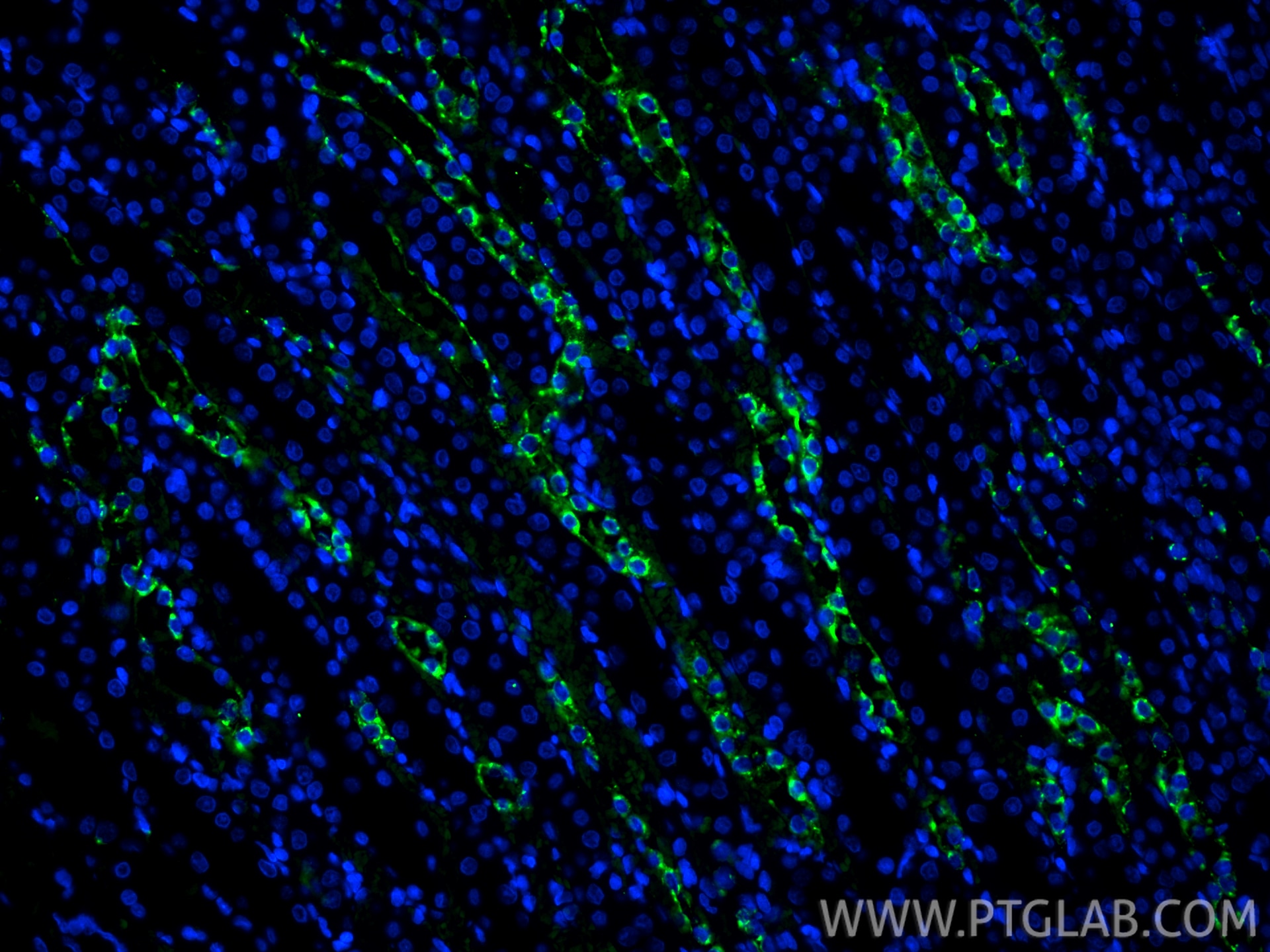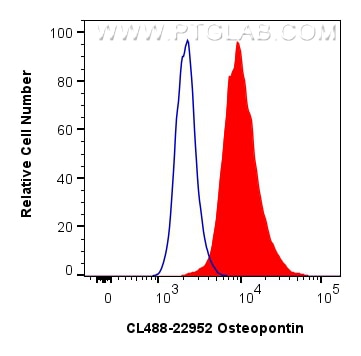- Featured Product
- KD/KO Validated
Osteopontin Polyklonaler Antikörper
Osteopontin Polyklonal Antikörper für IF-P, FC (Intra)
Wirt / Isotyp
Kaninchen / IgG
Getestete Reaktivität
human, Maus, Ratte
Anwendung
IF-P, FC (Intra)
Konjugation
CoraLite® Plus 488 Fluorescent Dye
Kat-Nr. : CL488-22952
Synonyme
Geprüfte Anwendungen
| Erfolgreiche Detektion in IF-P | Rattennierengewebe |
| Erfolgreiche Detektion in FC (Intra) | HepG2-Zellen |
Empfohlene Verdünnung
| Anwendung | Verdünnung |
|---|---|
| Immunfluoreszenz (IF)-P | IF-P : 1:50-1:500 |
| Durchflusszytometrie (FC) (INTRA) | FC (INTRA) : 0.80 ug per 10^6 cells in a 100 µl suspension |
| It is recommended that this reagent should be titrated in each testing system to obtain optimal results. | |
| Sample-dependent, check data in validation data gallery | |
Veröffentlichte Anwendungen
| IF | See 1 publications below |
Produktinformation
CL488-22952 bindet in IF-P, FC (Intra) Osteopontin und zeigt Reaktivität mit human, Maus, Ratten
| Getestete Reaktivität | human, Maus, Ratte |
| In Publikationen genannte Reaktivität | Maus |
| Wirt / Isotyp | Kaninchen / IgG |
| Klonalität | Polyklonal |
| Typ | Antikörper |
| Immunogen | Osteopontin fusion protein Ag19216 |
| Vollständiger Name | secreted phosphoprotein 1 |
| Berechnetes Molekulargewicht | 314 aa, 35 kDa |
| Beobachtetes Molekulargewicht | 70 kDa, 44-66 kDa |
| GenBank-Zugangsnummer | BC007016 |
| Gene symbol | Osteopontin |
| Gene ID (NCBI) | 6696 |
| Konjugation | CoraLite® Plus 488 Fluorescent Dye |
| Excitation/Emission maxima wavelengths | 493 nm / 522 nm |
| Form | Liquid |
| Reinigungsmethode | Antigen-Affinitätsreinigung |
| Lagerungspuffer | PBS with 50% glycerol, 0.05% Proclin300, 0.5% BSA |
| Lagerungsbedingungen | Bei -20°C lagern. Vor Licht schützen. Nach dem Versand ein Jahr stabil. Aliquotieren ist bei -20oC Lagerung nicht notwendig. 20ul Größen enthalten 0,1% BSA. |
Hintergrundinformationen
Osteopontin (OPN), also known as SPP1, is a secreted glycophosphoprotein that belongs to the small integrin-binding ligand N-linked glycoprotein (SIBLING) family. Originally isolated from bone, OPN has been found in kidney, vascular tissues, biological fluids, and various tumor tissues (PMID: 15138464; 16406521). OPN can interact with CD44 and integrins and regulate diverse biological processes. It has a multifaceted role in bone development and remodeling, and is also involved in the inflammatory and immune response, oncogenesis and cancer progression. The very acidic nature of OPN, as well as the presence of variable posttranslational modifications, has led to anomalous migration in SDS-polyacrylamide gels and therefore to reports of different molecular weights for OPN (PMID: 8293561). Depending on the cell and tissue source and/or the SDS-PAGE system, OPN migrates with a molecular weight of 44-80 kDa, as well as at some smaller bands correspond to peptide fragments (PMID: 8195113; 17890765).
Protokolle
| PRODUKTSPEZIFISCHE PROTOKOLLE | |
|---|---|
| IF protocol for CL Plus 488 Osteopontin antibody CL488-22952 | Protokoll herunterladen |
| FC protocol for CL Plus 488 Osteopontin antibody CL488-22952 | Download protocol |
| STANDARD-PROTOKOLLE | |
|---|---|
| Klicken Sie hier, um unsere Standardprotokolle anzuzeigen |
Publikationen
| Species | Application | Title |
|---|---|---|
J Lipid Res sEV-mediated Lipid Droplets Transferred from Bone Marrow Adipocytes promote ferroptosis and impair Osteoblast Function | ||
Nat Commun Cholangiocarcinoma PDHA1 succinylation suppresses macrophage antigen presentation via alpha-ketoglutaric acid accumulation | ||
Nat Commun SPP1 + macrophages cause exhaustion of tumor-specific T cells in liver metastases | ||
Cardiovasc Ther Thrombospondin-1 Silencing Ameliorates Osteoblastic Differentiation of Aortic Valve Interstitial Cells via Inhibiting Nuclear Factor-κB Pathway |



